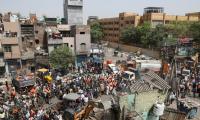LAHORE: Prudent management of resources is a major issue these days. We have surplus power, but we face loading, we are short in gas but we fail to plan LNG imports in time.
The inability of the government to control prices of essential commodities has been well documented. Price control should have come mainly from the provincial governments that have failed miserably.
Federal government policies of stabilisation took the breath out of the poor and then its stimulus policy without available resources has ensured that high prices continue to prevail. The petroleum fiasco after the crude oil prices nosedived is another proof of gross mismanagement.
We dole out subsidies equitably among few exporting sectors without realising that some sectors that consume high power and energy have low potential for exports and their product used as raw material by value-added sector costs more than global prices despite heavy subsidy.
It is interesting to note that the use of industrial power and energy in Bangladesh is much lower than Pakistan. This gives an impression that industrialisation in Pakistan is much higher than Bangladesh. Experts usually miss the point that despite a low industrial base, exports from Bangladesh are much higher than Pakistan. Bangladeshis also provide very high employment per MW of industrial power used.
Any subsidy that the Bangladesh government offers to its exporting sectors goes mainly to the most efficient industries. Our planners are afraid of alienating powerful vested interests, and this hinders the growth of our value-added sectors. Skewed policies and faulty subsidies have made all subsidised sectors inefficient.
A faulty concept was introduced in our industrial policy to protect industries established in Pakistan, irrespective of their production capacity.
This resulted in establishment of small raw material plants that hardly fulfil 10 percent needs of local industry, but these plants enjoy protection on the basis of which they keep their rates a shade below the protection they enjoy.
This price is always higher than the global rates of that raw material. The industry using that raw material is constrained to bear the high cost of the 90 percent raw material that they have to import. The protection period should not be more than five years. If during that period an industry fails to compete globally, the government should let it die.
Our efficiencies have deteriorated considerably, which can be judged from the fact that during the Musharraf era, yarn import was zero-rated and hardly any yarn was imported. We were the most sought-after global yarn suppliers.
Foreign yarn market has gradually dried for Pakistan and the industry is supplying yarn mainly to domestic industry on the strength of duty protection.
Self-praise is the refined form of self-denial. Our planners claim that Pakistan’s economy has performed better than all regional economies after Covid-19, but that is not true.
Our economy revived earlier due to better management of the pandemic (a rare feat) but our two rivals China and India have made up for the time lost, while Bangladesh has been slow to recover.
The Chinese economy is booming against all odds and Indians have recovered remarkably. Indian merchandise exports in April-August 2021 stood at $163.67 billion, an increase of 66.92 percent over $98.05 billion in April-August 2020 and an increase of 22.93 percent over $133.14 billion in the pre-Covid period of April-August 2019.
We are not in our comfort zone and cannot bear the continuous cost of mismanagement. Renowned economist Hafeez Pasha last month warned of four grave challenges that Pakistan is likely to face.
These challenges were the 4th wave of Covid, the next was the fall out of Afghan war, the third and the gravest was the economic uncertainty created by massive imports that may badly disturb our current account position.
All these factors have now become a reality. The rupee is under pressure not only because of higher imports, but also dollar buying from Afghans.
The security situation has been managed by the armed forces, but we cannot rule out infiltration of undesired elements from Afghanistan. The fourth challenge is that of the International Monetary Fund (IMF).
We are not on the same page with IMF on many issues. Our foreign financing badly depends upon a letter of comfort from the IMF.
Talks with the IMF have remained stalled for over 15 months and the Bretton Woods institution has shown remarkable patience. But for how long?
Honda officials posing for a photgraph. —APP/FileKARACHI: Honda Atlas Cars Pakistan Ltd has achieved a major...
SOS children village's children showing bags donated by Emirates International Airlines. — Emirates...
Automobiles at the shipping terminal are shown from the view of a drone in San Diego, California, US, March 26, 2025....
Key challenge lies in whether the ruling elite is willing to implement changes that could weaken their grip on power
A woman holds a smartphone displaying the logo of social network X . — AFP/FileElon Musk said his xAI artificial...
A representational image of a person using his cellphone for a digital transaction. — Unsplash/FileKARACHI: Chief...







